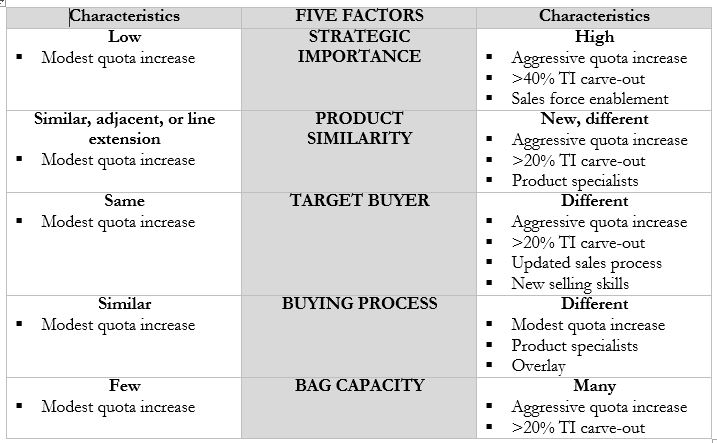Get confident about setting new product quotas: five things to consider

Setting accurate quotas is tough. It tops the list of challenges for most sales leaders. What’s even more challenging than setting accurate quotas? Assigning quotas for a new product. With new products, you have even less to work with – no historical sales data or performance data. So how do companies do this, and do it well?
Unfortunately there is no simple formula. But, here are five fundamental factors you should consider each time you launch a new product and want to assign responsibility to the sales force to go out and sell it.

1. Strategic Importance. Is the new product ‘the big bet’ for the organization? If the success of the organization depends on the new product’s success, then you’ll want to set aggressive goals, and be prepared to enable the sales force to succeed. Your primary sellers should have a “carve out” from their Target Incentive (TI) based roughly on how much time and attention you want them to give the new product. A carve out of 15-20 percent is a start. But only 40 percent or greater will garner serious attention.
2. Product Similarity. What is the nature of the new product? Is it a line extension, an adjacent or complimentary offering? If it’s similar, and the rep can easily understand it and sell it along with existing products, then a modest increase in quotas to reflect the new product potential is likely enough. If the product is significantly different, particularly if it’s more complex, simply raising quotas may not work. Reps may need additional training and enablement, including deploying overlay product specialists who are tied 100 percent to the new product. To drive core rep focus, carve out TI and assign a portion of it to the new product quota.
3. Target Buyer. Is the new product something you see your reps selling to their existing buyers? Or is it intended for a different target buyer? If the new product is a complement to the current suite of products, then adoption is often smoother. Modest increases in quotas for your core reps may do the trick to capture the added opportunity in each sales rep’s bag. However, if the new product is intended for a new buyer, get ready for resistance. Your top sellers will typically ‘get it,’ particularly if the average sales price (ASP) for the new product is significantly higher that their current go-to. But your core will likely remain entrenched and will resort to comfort-zone selling. Selling this new product requires bigger behavioral change. This may entail support and enablement in the form of updating the sales process, selling skills and overlay resources like product specialists. And the new product quotas may need to be “carved out” of TI (20 percent or more) to garner enough attention.
4. Buying Process. What is the process for selling the new product? Is it similar to existing products? Do you believe it will have a similar sales cycle? If the process is similar to your existing products it should be easier to integrate and therefore easier for your reps to sell. Modest quota adjustments should be sufficient. But if the buying process is quite different – particularly if it’s longer and more complex, just adding quota will likely not work. New product quota may need to be focused on overlay roles like new product specialists, and introduced gradually in to core rep quotas. Depending on the importance of the new product, you may consider offering a multiplier on new product sales or a higher acceleration rate beyond quota once the new product target is achieved.
5. Bag Capacity. How full is your sales rep’s bag? The number of products in the sales rep’s bag can have an impact on how much focus the new product gets. If a sales rep already has a large suite of products, the new addition may get lost in the shuffle. To drive focus, it’s common to set aggressive goals and get the rep’s attention. Conversely, if the new product is only a second or third offering you’re adding to the rep’s bag, the focus is almost unavoidable. In this scenario the new product quota will likely be a significant portion of a rep’s overall quota.
If setting quotas is tough, then setting new product quotas can be downright scary. However, careful consideration of several key factors should help you make sound decisions. As we’ve shown, it’s not always the best strategy to press ahead aggressively or to timidly approach quota allocation year over year. Every sales organization struggles with quota setting. And it will always be part art/part science. Consider these five factors when setting new product quotas and feel confident you’ve nailed the science part.
To learn more about quota allocation best practices, please visit Sales Quotas.